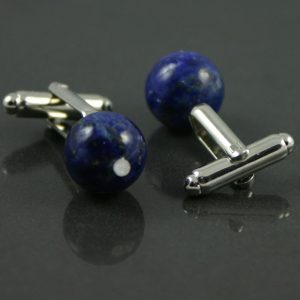Lapis Lazuli
The name Lapis Lazuli is derived from the Latin word for “Stone” and the Arabic word for “Blue”. It is not considered a mineral itself but rather is a rock. As it is composed of several minerals in addition to Lazurite which accounts for typically 25 to 40 percent of the gemstone. The other minerals it can contain include: augite, calcite, diopside, enstatite, mica, hauynite, hornblende, nosean, sodalite, and pyrite. The most valuable colour is a uniform deep blue with a tint of violet. With a small amount of evenly distributed golden pyrite, which creates the “starry night” appearance. Too much pyrite however, will result in the stone having a greenish tint, which is not desirable. The finest quality Lapis Lazuli comes from the Sar-i Sang mines in the western Hindu Kush mountains in northeastern Afghanistan.
 Formation: Lapis Lazuli is a metamorphic rock, composed of 25 to 40 percent Lazurite and other minerals such as calcite, pyrite and sodalite. The host rock is normally limestone or marble. Over time, geological processes can subject the host rock to intense heat and pressure. This heat and pressure causes chemical changes in the existing minerals within the host rock, forming new minerals including Lazurite. The resulting Lapis Lazuli is a combination of different minerals and host rock. The blue colour is from the presence of Luzurite, the golden flecks are from pyrite and the white colour if present, is from calcite.
Formation: Lapis Lazuli is a metamorphic rock, composed of 25 to 40 percent Lazurite and other minerals such as calcite, pyrite and sodalite. The host rock is normally limestone or marble. Over time, geological processes can subject the host rock to intense heat and pressure. This heat and pressure causes chemical changes in the existing minerals within the host rock, forming new minerals including Lazurite. The resulting Lapis Lazuli is a combination of different minerals and host rock. The blue colour is from the presence of Luzurite, the golden flecks are from pyrite and the white colour if present, is from calcite.
The primary source of the world`s finest Lapis Lazuli is from the Sar-i Sang mines in the Badakhshan province of northeastern Afghanistan. Other deposits are found in Russia, Chile, the United States, Pakistan and Myanmar.
Treatment: Fine quality, natural and untreated Lapis Lazuli is highly sought after and is considered the most valuable. For lower quality specimens, there are a number of treatments commonly applied to improve it appearance and durability.
Dyeing: For lower quality specimens, containing white calcite, these are normally dyed a deep blue to hide the white calcite and give a uniform intense blue colour. Note: These dyes can be unstable and as such tend to fade. Extra care should be taken with dyed specimens as they are more sensitive to sunlight and heat than the untreated varieties.
Wax/Oil: This gemstone can be quite porous, so to improve its lustre a surface coating of wax or oil can be applied and buffed in. This will fill any minor surface imperfections and give the stone a richer colour. It should be noted that wax or oil treatments are temporary and will need to be reapplied occasionally.
Polymer Impregnation: Lower quality specimens which are particularly porous, can be impregnated with a polymer or a resin. This will strengthen the stone and improve its lustre. This treatment is permanent.
Durability: Lapis Lazuli has a hardness rating of 5 to 6 on the Mohs scale, making it a relatively soft gemstone. As such it is not suitable for everyday wear but rather for occasional wear. Particularly when worn as rings or bracelets, which are frequently subjected to impacts. This gemstone is sunlight sensitive, prolonged exposure to sunlight will cause it to fade in colour. As such it should be stored in a cool, dark place when not being worn. It is also recommended to not allow it to come into contact with other jewellery as it is easily scratched. Care should also be taken with regards to cleaning agents and lotions or perfumes as these can cause the stone to fade in colour.
Meaning and Healing Properties
Lapis Lazuli has often been called the “Stone of Wisdom” and has long been associated with truth, wisdom and both enlightenment of the mind and spiritual enlightenment. It was said to promote inner peace and clarity, while at the same time protecting the wearer from negative energy. The stone is strongly associated with mental and emotional healing. It is said to reduce stress and create an inner calmness, allowing creativity to flow. This gemstone was also said to boost the immune system, alleviate ailments of the throat and to provide pain relief, particularly to those suffering from migraines and headaches.
Chakra: Lapis Lazuli is mainly associated with the third eye chakra, which helps to promote wisdom, intuition and spiritual enlightenment. It is also associated with the throat chakra, which promotes communication and speaking the truth.
Birthstone: Lapis Lazuli is an alternative birthstone for September. September`s traditional birthstone is Sapphire.
Zodiac Astrology: Lapis Lazuli is most closely associated with the star signs Sagittarius and Virgo.
Wedding Anniversary: Lapis Lazuli is the traditional gemstone for the 9th wedding anniversary.
History
 Lapis Lazuli and its uses in both jewellery and decorative objects has a very long history dating back over 9,000 years. The earliest mining of this gemstone took place in the Sar-i Sang mines in northeastern Afghanistan around 7,000 BC. Lapis Lazuli from the Sar-i Sang mines was and still is considered the finest in the world. From here it was traded across the ancient world. It was extensively used in the royal tombs of Ur (ancient Sumerian city-state) in Mesopotamia. The stone has also been found in Neolithic burial sites such as Mehrgarh (Pakistan) in the Indus Valley.
Lapis Lazuli and its uses in both jewellery and decorative objects has a very long history dating back over 9,000 years. The earliest mining of this gemstone took place in the Sar-i Sang mines in northeastern Afghanistan around 7,000 BC. Lapis Lazuli from the Sar-i Sang mines was and still is considered the finest in the world. From here it was traded across the ancient world. It was extensively used in the royal tombs of Ur (ancient Sumerian city-state) in Mesopotamia. The stone has also been found in Neolithic burial sites such as Mehrgarh (Pakistan) in the Indus Valley.
In Egypt, the stone was highly prized and considered as valuable as gold. Lapis beads were found at excavations of the predynastic site Naquda which were dated to between 3650 – 3300 BC. The ancient Egyptian`s associated the stone with the sun god Ra, giving it divine and royal status. One of the most famous examples of its use was in the death mask of the pharaoh Tukankhamun in the 14th Century BC. The Egyptians also ground the stone into a fine powder for use as an eyeshadow. Cleopatra is said to have worn Lapis eyeshadow, as did the high priests.
In ancient Greece and Rome, the stone was seen as a status symbol and highly sought after. The Roman scholar Pliny the Elder refers to the stone as “Sapphirus” describing it as a blue stone with gold flecks. Which has caused confusion with the corundum Sapphire.
During the Renaissance period, Lapis Lazuli was finely ground and used as a pigment called Ultramarine. At the time, Ultramarine was very expensive and was used to signify purity and divinity. Its use can be seen in paintings of the Virgin Mary and in the paintings of the Sistine Chapel. Famous Renaissance artists such as Titian, Vermeer and Michelangelo used Ultramarine in their masterpieces. In 1826, a synthetic Ultramarine was invented which was considerably cheaper. As a result, the use of lapis as a pigment when in to decline.
Currently, the Sar-i Sang mines in Afghanistan remain the world`s primary source of high quality Lapis Lazuli, estimated at 95% of global production.
Folklore
Throughout time, Lapis Lazuli has symbolised wisdom and truth. It was said to hold a connection to the divine and offer protection against evil. The Sumerians believed the gemstone held the soul of a deity and that the wearer of the stone would be granted divine favour.
In ancient Egypt, the stone was associated with the sun god Ra and they called it the “Stone of Heaven”. They believed the gemstone not only provided protection in this life but it could also protect in the afterlife, guiding souls to immortality. It was extensively used in burial objects for this reason. Egyptians also associated the stone with the goddess of truth, Maat. High priests and judges wore lapis amulets of Maat to signify their integrity.
Greek Mythology: In ancient Greece, Lapis was a very valuable gemstone and was believed to hold a divine connection. They linked the stone with Athena, goddess of war and wisdom. Wearing the stone was believed to connect the person with the gods and to gain their favour, along with protecting them. Due to its rarity and value it was seen as a symbol of power and status.
Roman Mythology: The ancient Romans associated Lapis with Venus, goddess of love and they sometimes called it the “Stone of Venus”. They believed the stone to be a potent aphrodisiac and they would grind it into a fine powder for consumption. They also used it as a pigment to create ultramarine, which was highly sought after by artists. They also associated the stone with courage and would gift it as a reward for displays of exemplary courage.
 Medieval Europe: In medieval Europe, Lapis Lazuli symbolised purity and the divine. It was rare and very expensive, often being referred to as “Blue Gold”. The primary use for Lapis during this time was as a pigment to make ultramarine. Ultramarine was widely used in Christian art, for example paintings of the Virgin Mary would depict her robes in ultramarine. It was also extensively used in manuscripts, frescoes and in ecclesiastical objects. A beautiful example of which can be seen in the Lapis Lazuli Tabernacle of the Cathedral of Palermo, Sicily. To a lesser extent because of its cost, it was sometimes used for medicinal purposes. It would be finely ground into a powder and used to treat ailments such as ulcers and eye problems.
Medieval Europe: In medieval Europe, Lapis Lazuli symbolised purity and the divine. It was rare and very expensive, often being referred to as “Blue Gold”. The primary use for Lapis during this time was as a pigment to make ultramarine. Ultramarine was widely used in Christian art, for example paintings of the Virgin Mary would depict her robes in ultramarine. It was also extensively used in manuscripts, frescoes and in ecclesiastical objects. A beautiful example of which can be seen in the Lapis Lazuli Tabernacle of the Cathedral of Palermo, Sicily. To a lesser extent because of its cost, it was sometimes used for medicinal purposes. It would be finely ground into a powder and used to treat ailments such as ulcers and eye problems.
Famous Lapis Lazuli



The above pieces are from the Lapis Lazuli, The Magic of Blue exhibition at the Uffizi Galleries in Florence, Italy.
Lapis Lazuli Gemological Data
Colour: Lazur blue, violet, greenish-blue.
Colour of Streak: Light blue.
Moh`s hardness: 5 – 6
Density: 2.50 – 3.00
Cleavage: Indistinct.
Fracture: Conchoidal, grainy.
Crystal system: Cubic, dense aggregates.
Transparency: Opaque.
Chemical composition: Na6Ca2[S,SO4,CI2)2IAI6Si6O24] sodium calcium aluminium silicate.
Refractive index: 1.50 approx.
Double refraction: None.
Pleochroism: Absent.
Dispersion: None.
Fluorescence: Strong: white, also orange, copper-colour.
For Researchers and Journalists
Recommended Citation (MLA) Format:
Hoyne, John. “Lapis Lazuli: Formation, History, Meaning, and Folklore.” Carus Jewellery, n.d., https://carusjewellery.com/lapis-lazuli/.
You can also get in touch with Carusjewellery.com on Facebook , where you may leave any comments or questions you may have about this article.





